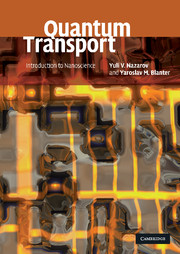Book contents
- Frontmatter
- Contents
- Preface
- Introduction
- 1 Scattering
- 2 Classical and semiclassical transport
- 3 Coulomb blockade
- 4 Randomness and interference
- 5 Qubits and quantum dots
- 6 Interaction, relaxation, and decoherence
- Appendix A Survival kit for advanced quantum mechanics
- Appendix B Survival kit for superconductivity
- Appendix C Unit conversion
- References
- Index
Introduction
Published online by Cambridge University Press: 05 June 2012
- Frontmatter
- Contents
- Preface
- Introduction
- 1 Scattering
- 2 Classical and semiclassical transport
- 3 Coulomb blockade
- 4 Randomness and interference
- 5 Qubits and quantum dots
- 6 Interaction, relaxation, and decoherence
- Appendix A Survival kit for advanced quantum mechanics
- Appendix B Survival kit for superconductivity
- Appendix C Unit conversion
- References
- Index
Summary
It is an interesting intellectual game to compress an essence of a science, or a given scientific field, to a single sentence. For natural sciences in general, this sentence would probably read: Everything consists of atoms. This idea seems evident to us. We tend to forget that the idea is rather old: it was put forward in Ancient Greece by Leucippus and Democritus, and developed by Epicurus, more than 2000 years ago. For most of this time, the idea remained a theoretical suggestion. It was experimentally confirmed and established as a common point of view only about 150 years ago.
Those 150 years of research in atoms have recently brought about the field of nanoscience, aiming at establishing control and making useful things at the atomic scale. It represents the common effort of researchers with backgrounds in physics, chemistry, biology, material science, and engineering, and contains a significant technological component. It is technology that allows us to work at small spatial scales. The ultimate goal of nanoscience is to find means to build up useful artificial devices – nanostructures – atomby atom. The benefits and great prospects of this goal would be obvious even to Democritus and Epicurus.
This book is devoted to quantum transport, which is a distinct field of science. It is also a part of nanoscience. However, it is a very unusual part. If we try to play the same game of putting the essence of quantum transport into one sentence, it would read: It is not important whether a nanostructure consists of atoms.
- Type
- Chapter
- Information
- Quantum TransportIntroduction to Nanoscience, pp. 1 - 6Publisher: Cambridge University PressPrint publication year: 2009



